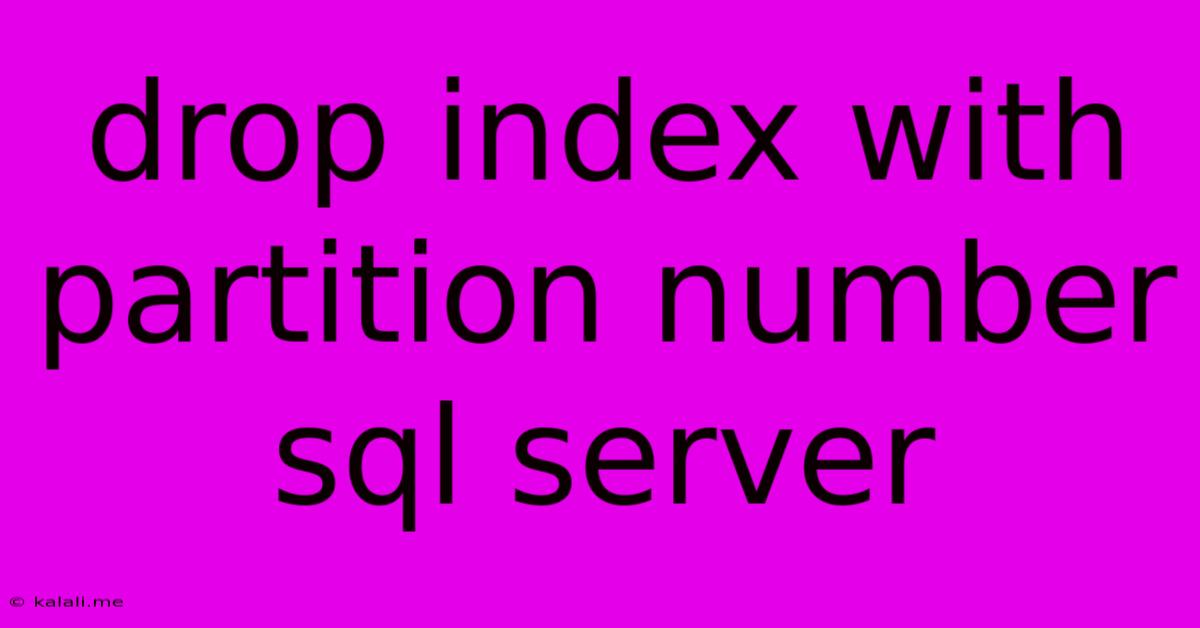Drop Index With Partition Number Sql Server
Kalali
Jun 03, 2025 · 3 min read

Table of Contents
Dropping Indexes on Partitioned Tables in SQL Server: A Comprehensive Guide
This article provides a comprehensive guide on how to efficiently drop indexes from partitioned tables in SQL Server. Understanding the nuances of partitioned tables and their indexes is crucial for maintaining database performance and manageability. Dropping the wrong index or using the wrong method can lead to significant performance degradation or even data loss. Therefore, a clear understanding of the process is paramount. This guide will cover various scenarios and best practices.
Understanding Partitioned Tables and Indexes
Before diving into the mechanics of dropping indexes, let's briefly review partitioned tables. A partitioned table is a table logically divided into smaller, more manageable sections called partitions. This partitioning strategy offers several benefits, including improved query performance, simplified data management (like archiving older data), and parallel processing capabilities. Indexes, in turn, speed up data retrieval by creating sorted structures of data based on specific columns. When working with partitioned tables, indexes are created and maintained on each partition individually.
Methods for Dropping Indexes on Partitioned Tables
There are several approaches to dropping indexes from partitioned tables in SQL Server, each with its own advantages and considerations:
1. Dropping Indexes Individually on Each Partition:
This method involves explicitly dropping the index from each partition individually. This provides granular control and allows for selective index removal, but it's less efficient for a large number of partitions. The process typically involves identifying each partition number and executing the DROP INDEX statement for each.
-- Example: Dropping index 'IX_MyIndex' from partition 1 of table 'MyPartitionedTable'
USE MyDatabase;
GO
DROP INDEX MyPartitionedTable.IX_MyIndex ON MyPartitionedTable PARTITION (1);
GO
This must be repeated for each partition.
2. Dropping the Index on the Table (Recommended):
The most straightforward and efficient approach is to drop the index at the table level. SQL Server intelligently handles the removal of the index from all partitions. This method simplifies the process and avoids the repetitive steps required for individual partition dropping.
-- Example: Dropping index 'IX_MyIndex' from 'MyPartitionedTable'
USE MyDatabase;
GO
DROP INDEX IX_MyIndex ON MyPartitionedTable;
GO
This is the recommended approach due to its simplicity and efficiency.
3. Using System Tables to Identify Partitions and Indexes (Advanced):
For more complex scenarios or automation purposes, you can leverage system tables like sys.partitions, sys.indexes, and sys.index_columns to dynamically identify partitions and their associated indexes. This allows for programmatic index management, particularly helpful in environments with a large number of partitions. This approach requires a more advanced understanding of SQL Server system tables and dynamic SQL. It would generally involve querying these tables to build a dynamic SQL script that drops the relevant indexes.
Best Practices and Considerations:
- Backup: Always back up your database before performing any index modifications, especially on partitioned tables. This protects against accidental data loss or corruption.
- Monitoring: Monitor performance before and after dropping indexes. While indexes generally improve performance, removing an important index can negatively impact query speed.
- Index Fragmentation: Regularly check and defragment your indexes to maintain optimal performance. Partitioned tables can be particularly susceptible to fragmentation.
- Planning: Carefully plan which indexes to drop. Dropping unnecessary indexes can improve performance, but removing crucial indexes can severely degrade performance.
- Alternatives to Dropping: Consider other options before dropping indexes, such as rebuilding or reorganizing them. This can often address performance issues without the need to remove the index entirely.
Conclusion:
Dropping indexes on partitioned tables in SQL Server requires careful planning and execution. While dropping the index at the table level is the recommended approach for simplicity and efficiency, understanding the other methods allows for greater control in specific situations. Remember to always back up your database and monitor performance before and after making any index changes. By following these guidelines, you can maintain optimal database performance and effectively manage your partitioned tables.
Latest Posts
Latest Posts
-
Ways To Display Skills Personal Website
Jun 05, 2025
-
Best Format For Time Machine Backups M1 Mac
Jun 05, 2025
-
How To Open A Garage Door Manually From The Outside
Jun 05, 2025
-
How To Move Faces Only In Blender
Jun 05, 2025
-
Judgment Seat Of Christ Vs Great White Throne
Jun 05, 2025
Related Post
Thank you for visiting our website which covers about Drop Index With Partition Number Sql Server . We hope the information provided has been useful to you. Feel free to contact us if you have any questions or need further assistance. See you next time and don't miss to bookmark.